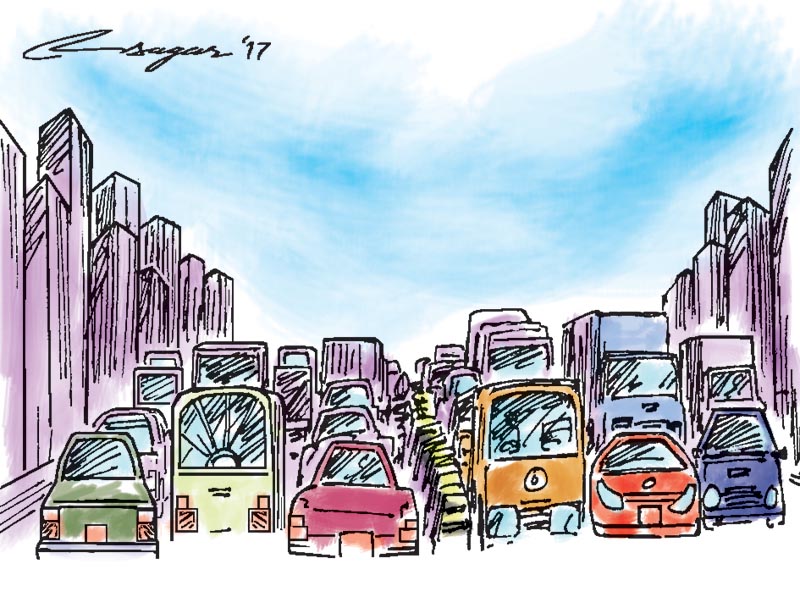Traffic problems: Viable solutions
The designers assume there are drivers, with a certain level of knowledge of environment, intellect to understand the existing situation, a standard level of driving skill and knowledge of the vehicle and a good sense of responsibility
Somewhere in the second week of Ashad, I happened to come across suggestions given to the concerned minister upon his call to submit viable solutions towards the improvement of traffic condition in Kathmandu within three days. I took it as the Nepal Government is facing a serious problem in the capital city of our country. We in Nepal are a happy go lucky people, we are ready to pay five hundred rupees per liter or stand in line twenty four hours to buy ten liters of petrol and then spend it carelessly. Petrol and diesel are very costly commodities in Nepal, we should be using it responsibly.
The suggestions given to the problem seems to be short term solutions only except for the one given by Mr. Ghising, to remove the private cars from the busy road during office hours and to allow odd and even number vehicles on the road each day.
Also I heard other suggestion of removing motorcycles from inside the Ring Road of Kathmandu. I also think this to be the only solution, but I would prefer to go by voluntary rather than forced removal from the road. We can encourage the vehicle owners to plough their cars on the road only when it is necessary. This much we can do to facilitate other country men who really need to travel.
Transportation in Nepal especially in Kathmandu is becoming more and more disturbing and dangerous. Some people are already thinking about road safety. But mobility is in high demand. So we do not want and cannot restrict the mobility and for this we can go for high occupancy vehicles. Yes the answer is improved public transportation and use of high occupancy vehicles.
Just a quick thought, I see more of official vehicles on the road at all times, how about we do something about them at the first stage. For example provide micro buses or other similar vehicles in certain points and route as an office transport for the employees and provide fewer cars with tracking system to the higher officials as needed for optimal utilization. This will reduce many cars/vehicles from the road. We certainly need to upgrade the public transportation, they are far from being safe, and attractive.
Every day many incidents happen while travelling, loading and unloading of the passengers, especially with the aged and the children.
These incidents are neither reported and/or recorded, hence the less accident statistics. Shall we ever have a minimum safety standards spelled by the government or just let it go.
May be even buses of two or more standard (with different pricing, restrictions and facilities) will be necessary to attract more motorists from using their vehicles all the time. This may even prove to be a way to improve existing public transportation. Restrictions must be with alternatives and not directed to minimize the mobility. We might think that widening of roads will help, it may make conditions better for a few days and always return to the same or worse condition.
In today’s world we are talking of sharing cars in Kathmandu, and this is already popular in India and much cheaper than taxis. Hiring of cars is getting very popular in neighboring China. You just do not buy cars to plough onto the ever worsening traffic jam.
Traffic management is very complex and we have to deal with it cautiously. Let us give ourselves a bit more time and come out with more sustainable solutions.
We need to have more comprehensive studies and approach to produce sustainable solutions. Only one entity cannot solve the problem, co-operation of the whole society is needed. Had it been so simple people might have given many suggestions long ago and we would not be facing this problem today.
Of course we can at the meantime take some of the positive suggestions given. They are not wrong but they tend to solve a particular side of the complex problem. We have a horrendous task in front of us. We have been neglecting it completely for decades and if we go on neglecting, one day cars will be on the road just standing and not moving.
Firstly, we shall have to understand some basics of travelling. Who are the stakeholders — the so called road users, what are their interests, or what do they want. There are pedestrians and vehicle users like cyclists, motorcyclists, the three wheel drivers, car drivers micro van drivers, bus drivers, school bus drivers, goods transporters, institutions carrying out road constructions and traffic management entities etc. and each group have a different wish list.
They may have different purpose for the trip, different attitudes and behaviors. What is the environment like road and climatic conditions, the road guide like road marking road signs traffic lights, in which we move. What is the noise, dust etc. pollution and climatic condition, road congestion. What is the physical and or mental condition of the individual?. The behavior or the decision making process of the road users definitely depend on some or all of these factors.
The designers assume there are drivers, with a certain level of knowledge of environment, intellect to understand the existing situation, a standard level of driving skill and knowledge of the vehicle, a good sense of responsibility. Did we ever try to understand these factors, otherwise how can we guide them on the road and make them behave as is duly expected?
Pradhan is a traffic engineer






